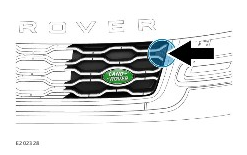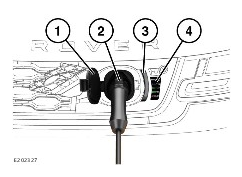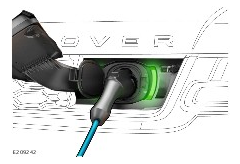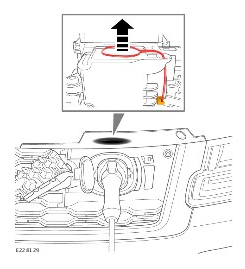2022 Land Rover Range Rover Sport VEHICLE CHARGING

VEHICLE CHARGING INTRODUCTION
A home charging cable is supplied with the vehicle. The home charging cable should be stored safely. The home charging cable should only be used if a public charging station, or wall-mounted charger, is not available. A public charging station, or wall-mounted charger, should be used whenever possible. Contact a retailer/authorized repairer in order to source a charging station.
The high-voltage system has no serviceable parts. Never disassemble, remove or replace high-voltage components, cables, or connectors. Tampering with the high voltage system can cause severe burns or electric shock, which may result in serious injury or death. High-voltage cables and connectors are colored oranges for identification purposes. If maintenance or repair is required, always consult a retailer/authorized repairer.
Do not expose the charging cable to rain, a direct jet of water, or a water splash. Do not immerse the charging cable in water.
Only connect charging cables to properly installed sockets, which meet national laws and standards and have been checked by a qualified technician. Serious damage may occur to the property and charging cable if the household supply is not appropriate for charging a hybrid vehicle.
Do not use a charging cable if there is any damage to the unit. If damage is apparent, contact a retailer/authorized repairer.
Do not use an extension lead or multiple sockets in order to extend the reach of a charging cable. Serious damage to the extension cable and the property may occur.
When traveling abroad, do not connect a plug adaptor to a charging cable. Serious damage to the adaptor and the property may occur.
The vehicle supports AC charging only.
Further user instructions for the Mode 2 Basic (Home Charge) cable can be found at: https://www.aptiv.com/user-manual
In some circumstances, the vehicle may not charge. A failure to charge is identified in the following ways:
- Via messages in the instrument panel and on the touchscreen.
- Via the charging port indicators.
- Via the charging cable indicators.
A failure to charge could be caused by:
- A vehicle battery fault.
- A high voltage cooling system fault.
- A fault with the electricity supply to the vehicle.
This list is not exhaustive. If the vehicle fails to charge, contact a retailer/authorized repairer.
CHARGING PORT LOCATION

The charging port is located behind the front grille. With the vehicle unlocked, pull the top right corner of the grille, in the position illustrated above, to gain access to the charging port. Once open, move the cap aside to gain access to the charging port.

- Charging port cap.
- Charging cable.
- Charging port LEDs. See CHARGING PORT INDICATORS.
- Charging port indicator label.
CONNECTING A CHARGING CABLE
When charging a Plug-in Hybrid Electric Vehicle (PHEV), always make sure that the charging cable is fully unwound. Failure to fully unwind the charging cable could lead to overheating of the cable.
Make sure you select the correct charging cable for your vehicle when using a public charging station. The charging cable should provide an AC charge, with a connector that matches the vehicle’s charging port.
Make sure that the AC charging cable meets standard SAE J1772.
To connect a charging cable to the vehicle:
- Unlock the vehicle.
- Make sure Park (P) is selected.
- Make sure the vehicle’s ignition is switched off.
- Plug in the domestic connector to the electricity supply.
NOTES
Always connect the charging cable to the electricity supply before connecting to the vehicle. See VEHICLE CHARGING INTRODUCTION.
- Open the charging port and remove the cap. See CHARGING PORT LOCATION.
- Connect the charging cable to the charging port.
The charging cable is locked in position once connected.
Do not attempt to pull the cable from the charging port once it is locked. Damage to the cable’s locking mechanism will result. Press the unlock button on the smart key if urgent disconnection is required. The cable’s locking mechanism re-engages after 60 seconds.
If the conditions listed 1-6 above have been met, the charging process starts automatically. See CHARGING PORT INDICATORS and CHARGING CABLE INDICATORS.
If a timed charging event has been set, the charging process may be delayed. See TIMED CHARGING OVERVIEW.
If a power cut occurs during the charging process, the charging process stops. The vehicle checks if power has been restored every 5 minutes. Once power is restored, the charging process resumes automatically.
A power cut may affect the vehicle’s ability to fully charge prior to embarking on a trip.
The vehicle is unable to start with the charging cable connected. See STARTING SAFETY.
CHARGING PORT INDICATORS

LEDs on either side of the charging port inform the user of the charging status. In certain conditions, the LEDs illuminate white to aid in connecting the charging cable in dark conditions.
A label adjacent to the charging port provides a quick reference to the behavior of the LEDs in relation to charging status, as follows.

The LEDs on either side of the charging port flash white briefly to confirm vehicle charging has been initialized.

The LEDs on either side of the charging port flash blue for 10 seconds to indicate a timed charging event has been set. The charging process will begin at a later time. See TIMED CHARGING.

The LEDs on either side of the charging port flash green for 10 seconds to indicate charging has started.

The LEDs on either side of the charging port illuminate green for 10 seconds to indicate that charging is complete.

The LEDs on either side of the charging port flash red for 30 seconds to indicate a charging fault. Check both ends of the charging cable are connected securely. If a public charging station is being used, check that the charging point has been authorized to start charging. If charging faults persist, contact a retailer/authorized repairer. Charging status can also be viewed via the MY EV touchscreen menu. See EXTRA FEATURES.
CHARGING CABLE INDICATORS
The home charging cable supplied with the vehicle contains 4 indicators to inform the user of its status.
| Power | Charging | Temperature | Fault | Description |
|---|---|---|---|---|
| Off. | Off. | Off. | Off. | No electrical supply was detected. |
| On. | Off. | Off. | Off. | Ready for operation. |
| On. | Flashing. | Off. | Off. | Charging in progress. |
| On. | On. | On. | On. | Self-test procedure in progress. |
| On. | Flashing. | On. | Off. | Slow charging due to increased temperature. |
| On. | Off. | On. | Off. | Charging inhibited due to temperature out of range. Protect cable and wallplug from excessive temperature and direct sunlight. |
| On. | Off. | Flashing. | Off. | The charging procedure was interrupted. Check all connections. |
| Off. | Off. | Off. | Flashing. | Charging fault. |
| Off. | Off. | Off. | On. | The power supply to the vehicle has failed. |
TIMED CHARGING OVERVIEW
Timed charging comprises two main features:
- Preferred charging period.
- Timed charging.
The preferred charging period feature allows the vehicle to use a cheaper rate of electricity based on your household tariff. When set, the vehicle attempts to charge the vehicle within the time window you select. Preferred charging can be set via vehicle preconditioning. See PRECONDITIONING SETTINGS. By setting a departure time, the timed charging feature makes sure that the vehicle is in an optimum state of charge prior to a trip. The timed charging feature attempts to charge the vehicle within the preferred charging time window. See PRECONDITIONING SETTINGS.
If it is not possible to fully charge the vehicle within the preferred charging window, charging may begin before this time make sure to fully charge before the set departure time
PREFERRED CHARGING TIME
To set a preferred charging time, from the TOUCHSCREEN HOME MENU select Extra Features. See EXTRA FEATURES:
- From the EXTRA FEATURES screen, select Vehicle Departures.
- Select NEW DEPARTURE TIME.
- Select Timed Charging.
- Use the up and down arrows to set a start and end time.
- Select OK.
The preferred charging time settings remain in the vehicle’s memory and can be reset if necessary.
TIMED CHARGING
To set a timed charging event, from the TOUCHSCREEN HOME MENU select Extra Features. See EXTRA FEATURES:
- From the EXTRA FEATURES screen, select Vehicle Departures.
- Touch the VEHICLE DEPARTURES screen to select a date and time for departure.
- Use the up and down arrows to adjust the start time, if necessary.
- Select Only… to set a single event. Select Repeating to set a repeating event.
- Select Timed Charging or Timed Charging and Timed Climate.
- Select OK.
The first time a timed charging event is set the PREFERRED CHARGING PERIOD screen displays. Use the up and down arrows to select a charging period that takes advantage of the most environmental and economical charging times. If required, the preferred charging period can be changed via the settings menu.
DISCONNECTING A CHARGING CABLE
To disconnect a charging cable:
- Make sure the vehicle is unlocked.
NOTES
The vehicle can be unlocked using the smart key or the keyless entry system. See UNLOCKING THE VEHICLE and PASSIVE ENTRY.
- Make sure Park (P) is selected.
- Make sure the vehicle’s ignition is switched off.
- If the charging cable is fitted with a release button, press the release button and disconnect the charging cable from the vehicle.
NOTES
Always disconnect the charging cable from the vehicle first.
- Fully close the charging port’s cover.
- Remove the domestic connector from the electricity supply.
NOTES
This applies only to home charging cables.
Do not attempt to pull the cable from the charging port when it is locked. Damage to the cable locking mechanism will result. Press the unlock button on the smart key if the urgent disconnection is required. The cable’s locking mechanism re-engages after 60 seconds.
CHARGING CABLE EMERGENCY RELEASE
Keep hands and clothing away from drive belts, pulleys, and fans. Some fans may continue to operate, or start operating after the engine has stopped. Failure to do so could potentially result in serious injury or death in the event of an accident.
The following process should only be used if all other attempts to disconnect the charging cable from the vehicle have failed. If the charging cable fails to release regularly, contact a retailer/authorized repairer.

To release the charging cable in an emergency, carry out the following:
- Open the hood.
- Locate the access hole.
- Pull the red ring upwards to release the cable.

